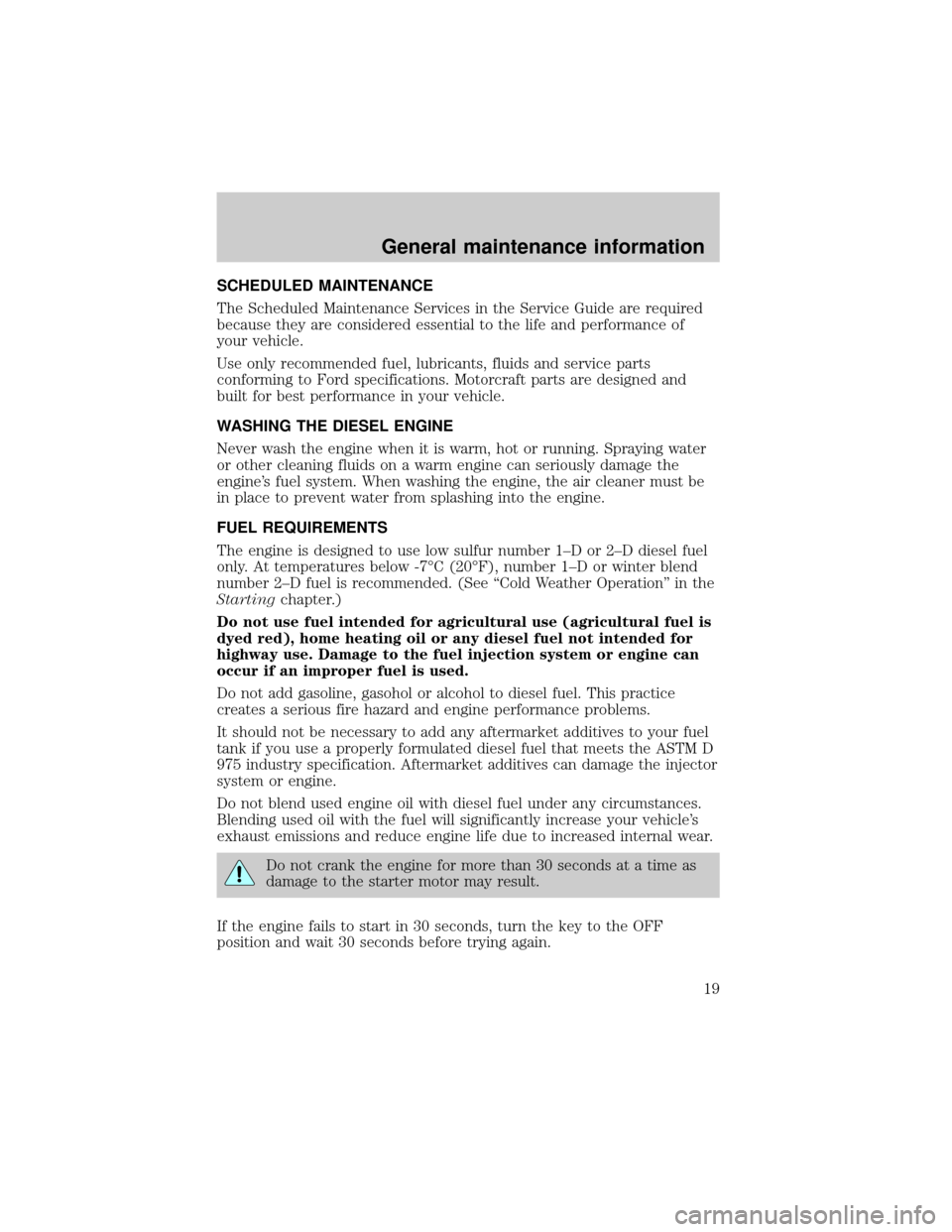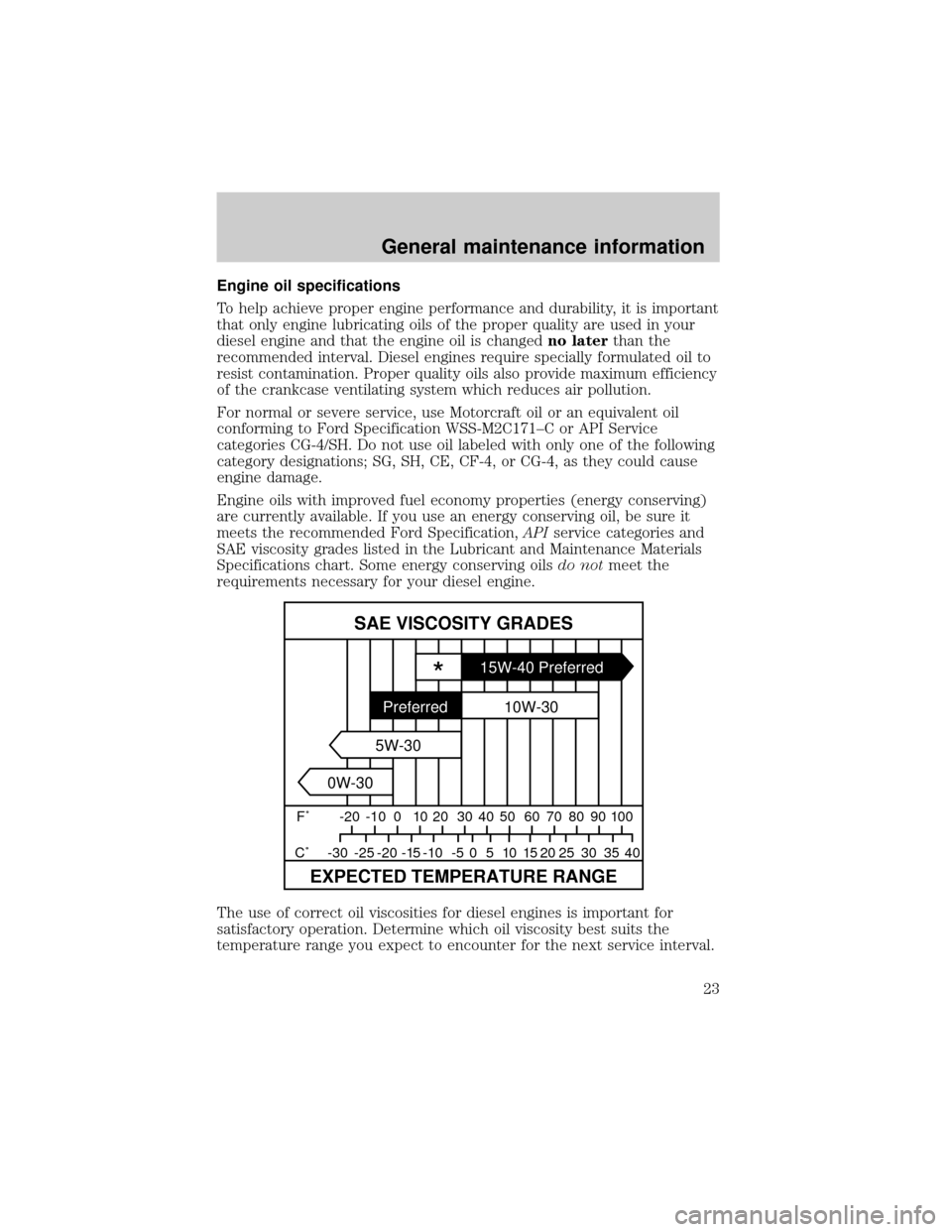Page 17 of 39
AUXILIARY POWERTRAIN CONTROL MODULE (APCM)
(IF EQUIPPED)
Your vehicle may be equipped with an auxiliary PCM. It has the following
features:
RPM control
This feature is used for elevating the
engine's idle speed. Rpm control can
be activated from inside the vehicle
and can be programmed to activate
automatically upon engine start-up.
Programmable speed presets range
from 1300±2500 rpm. This is the
recommended method of elevating
idle speed for PTO applications.
Charge Protect
This feature is used for maintaining
battery charge. In ªCharge
Protectionº mode, the battery
voltage is monitors and the engine
idle speed is increased so the
battery charge is maintained as
required. Charge Protection can be
activated from inside the vehicle
and programmed to activate
automatically upon engine start-up.
LCD screen
Displays current engine speed and
battery voltage.
RPM
CONTROLCHARGE
PROTECTPOWER
RPM
CONTROLCHARGE
PROTECTPOWER
RPM
CONTROLCHARGE
PROTECTPOWER
Driving tips
17
Page 18 of 39
Arrow keys
Each arrow key contains a preset
speed allowing four programmable
rpm settings. The arrow keys can
also be used to manually increase or
decrease engine idle speed at a
faster of slower rate.
RPM
CONTROLCHARGE
PROTECTPOWER
Driving tips
18
Page 19 of 39

SCHEDULED MAINTENANCE
The Scheduled Maintenance Services in the Service Guide are required
because they are considered essential to the life and performance of
your vehicle.
Use only recommended fuel, lubricants, fluids and service parts
conforming to Ford specifications. Motorcraft parts are designed and
built for best performance in your vehicle.
WASHING THE DIESEL ENGINE
Never wash the engine when it is warm, hot or running. Spraying water
or other cleaning fluids on a warm engine can seriously damage the
engine's fuel system. When washing the engine, the air cleaner must be
in place to prevent water from splashing into the engine.
FUEL REQUIREMENTS
The engine is designed to use low sulfur number 1±D or 2±D diesel fuel
only. At temperatures below -7ÉC (20ÉF), number 1±D or winter blend
number 2±D fuel is recommended. (See ªCold Weather Operationº in the
Startingchapter.)
Do not use fuel intended for agricultural use (agricultural fuel is
dyed red), home heating oil or any diesel fuel not intended for
highway use. Damage to the fuel injection system or engine can
occur if an improper fuel is used.
Do not add gasoline, gasohol or alcohol to diesel fuel. This practice
creates a serious fire hazard and engine performance problems.
It should not be necessary to add any aftermarket additives to your fuel
tank if you use a properly formulated diesel fuel that meets the ASTM D
975 industry specification. Aftermarket additives can damage the injector
system or engine.
Do not blend used engine oil with diesel fuel under any circumstances.
Blending used oil with the fuel will significantly increase your vehicle's
exhaust emissions and reduce engine life due to increased internal wear.
Do not crank the engine for more than 30 seconds at a time as
damage to the starter motor may result.
If the engine fails to start in 30 seconds, turn the key to the OFF
position and wait 30 seconds before trying again.
General maintenance information
19
Page 20 of 39

Truck stops have pumps and nozzles designed for larger, heavy-duty
trucks. When refueling at truck stops: if the nozzle shuts off repeatedly
when refueling, wait 5±10 seconds; then use a slower rate of flow (don't
depress the nozzle trigger as far).
If air is allowed to enter the fuel system (during fuel filter change or if
you run out of fuel) the engine will purge the trapped air as it runs. The
engine may run rough and produce white smoke while air is in the
system. This is normal and should correct itself in a short time.
An engine that suddenly becomes noisy or operates poorly after a fuel fill
could be using substandard fuel (i.e., high water content, low octane
rating or gasoline in the fuel). Diesel fuel should be purchased from a
reputable station which sells a large amount of diesel fuel.
Care should be taken whenever diesel fuel is stored. Use only clean,
approved containers which will prevent the entry of dirt or water.
Diesel fuel must not be stored in a galvanized container. The fuel will
dissolve the zinc in a galvanized container. The zinc will then remain in
solution until it is run through the engine where it will be deposited in
the fuel injectors causing expensive-to-repair damage.
General maintenance information
20
Page 21 of 39
CHANGING FUEL FILTER
Removal
1. Remove fuel filter cap by turning
counterclockwise. Fuel filter
element will come out with cap.
2. Remove and discard bevel gasket. Carefully clean mating surfaces.
3. Press in on fuel filter element locking tabs, to separate element from
cap.
Installation
The engine will not run properly if the fuel filter is not installed
in housing.
1. Apply a coating of clean diesel fuel to new bevel gasket and install
onto fuel filter housing gland.
2. Install new fuel filter element onto cap. Place new fuel filter element
and cap into fuel filter housing. Allow fuel to soak into fuel filter
element. Tighten cap onto fuel filter housing until cap contacts the
aluminum housing.
Fuel with more than average impurities may require more frequent filter
changing intervals.
General maintenance information
21
Page 22 of 39

After changing the fuel filter, the engine will purge the trapped air as it
runs. Engine may run roughly and smoke until the air is completely
eliminated.
ENGINE OIL
Checking engine oil level
Because it is normal to add some oil between oil changes, check your
engine oil level each time you stop for fuel. To check the engine oil level
consistently and accurately, the following procedure is recommended:
1. Have engine at normal operating temperature (at least into the
NORMAL range on the engine coolant temperature gauge).
2. Park the vehicle on a level surface, then turn off the engine and open
the hood.
4. Allow at least20 minutesafter engine shutdown to assure that the oil
contained in the upper parts of the engine has returned to the oil pan.
5. Protecting yourself from engine
heat, pull out the dipstick, wipe it
clean and reinsert fully.
6. Read oil level on both sides of dipstick and use highest level (reading)
for the actual engine oil level.
7. Maintain the oil level between ADD and OPERATING RANGE on the
dipstick by adding oil as required. The distance from ADD to
OPERATING RANGE on the dipstick represents 1.9L (2 quarts). Do not
overfill. If the oil level exceeds OPERATING RANGE, oil consumption
may result.
General maintenance information
22
Page 23 of 39

Engine oil specifications
To help achieve proper engine performance and durability, it is important
that only engine lubricating oils of the proper quality are used in your
diesel engine and that the engine oil is changedno laterthan the
recommended interval. Diesel engines require specially formulated oil to
resist contamination. Proper quality oils also provide maximum efficiency
of the crankcase ventilating system which reduces air pollution.
For normal or severe service, use Motorcraft oil or an equivalent oil
conforming to Ford Specification WSS-M2C171±C or API Service
categories CG-4/SH. Do not use oil labeled with only one of the following
category designations; SG, SH, CE, CF-4, or CG-4, as they could cause
engine damage.
Engine oils with improved fuel economy properties (energy conserving)
are currently available. If you use an energy conserving oil, be sure it
meets the recommended Ford Specification,APIservice categories and
SAE viscosity grades listed in the Lubricant and Maintenance Materials
Specifications chart. Some energy conserving oilsdo notmeet the
requirements necessary for your diesel engine.
The use of correct oil viscosities for diesel engines is important for
satisfactory operation. Determine which oil viscosity best suits the
temperature range you expect to encounter for the next service interval.
SAE VISCOSITY GRADES
EXPECTED TEMPERATURE RANGE
F˚ -20 -10 0 10 20 30 40
40 35 30 25 20 15 10 5 0 -5 -10 -15 -20 -25 -30 C˚50 60 70 80 90 100
*15W-40 Preferred
10W-30
5W-30
0W-30Preferred
General maintenance information
23
Page 24 of 39

A symbol has been developed by the
American Petroleum Institute (API)
to help you select the proper engine
oil. It will be included on the oil
container you purchase. The top
section of the symbol shows the oil
performance by the API designation.
This should match the owner guide recommendation. The center section
will show the SAE viscosity grade. The lower section will state energy
conserving if the oil has proven fuel saving capabilities.
Changing engine oil and filter
Change your oil and filter according to the ªService Guideº. Change more
frequently if your vehicle operation includes extended periods of idling
or low-speed operation, driving for a long time in cold temperatures or
driving short distances. See the following section ªEngine Lubrication for
Severe Service Operationº for all severe duty restrictions.
Use Ford Engine Oil Filter Part No. F4TZ-6731±A (FL±1995) or
equivalent. These filters protect your engine by filtering harmful,
abrasive or sludge particles. The FL±1995 filters particles significantly
smaller than most available ªwill fitº filters.
To replace, use an oil filter wrench to unscrew the filter from the oil
cooler fitting. Turn it horizontally to let excess oil drain off, and remove.
Do not handle a hot oil filter with bare hands.
Clean the filter mounting area on the oil cooler, lightly coat the gasket
surface of the new filter with clean engine oil and hand tighten until the
gasket contacts the base.Then tighten another 1±1/4 to 2 turns.Fill
the crankcase and run the engine to check for leaks.
Continuous contact with USED motor oil has caused cancer in
laboratory mice. Protect your skin by washing with soap and
water.
APISERVICECG-4/SHSAE15W-40
General maintenance information
24